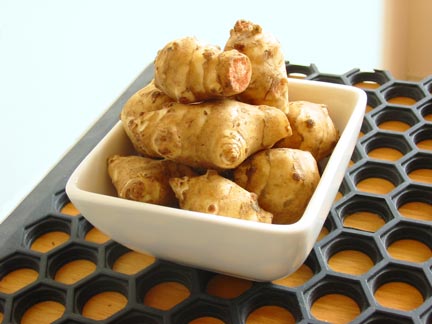 The sunchoke, otherwise known as the Jerusalem artichoke was unfamiliar to me. Sure I’d read about it, even heard about this little knobby tuber in certain circles; I just had never gotten around to trying it. That was until this week, when the gorgeous buttery, potatoey, artichoky bulb came into my home via a Berkeley Bowl bag.
The sunchoke, otherwise known as the Jerusalem artichoke was unfamiliar to me. Sure I’d read about it, even heard about this little knobby tuber in certain circles; I just had never gotten around to trying it. That was until this week, when the gorgeous buttery, potatoey, artichoky bulb came into my home via a Berkeley Bowl bag.

Berkeley Bowl is a legendary Berkeley market with an enormous produce section– enormous. It is not unusual to find seven different types of eggplant there, all lined up in various shades of purple. As I was strolling around the produce section I spotted them,the sunchoke, pimply, knuckly, with a sheer tan skin, they actually looked like hands of ginger. So I snatched them up and brought them home, unsure what I would do with them.
I scoured my cookbooks. Mark Bittman in How to Cook Everything, has only one recipe for Crisp Cooked Sunchokes that I wasn’t too keen on; I could do better. Alice Waters in Chez Panisse Vegetables doesn’t even mention the sunchoke, and yet she mentions a vegetable as unique as cardoons. What kind of bourgie does she think she is? Then I went on-line, expecting to find a plethora of recipes. I did Google searches for both sunchokes and Jerusalem artichokes, I searched epicurious.com, Cooks Illustrated, and many more. And I found recipes, just none about which I was all too excited. Most of them were for purees or silky soups, but it’s spring and I wanted something light, something that adequately displayed my newfound vegetable. And so those sunchokes sat on the kitchen counter taunting me with their dirty looks, begging for me to cook them.
And so I did; and they were delightful. I learned a lot about the sunchoke in my research. They are a tuber, very nutritious, high in vitamin C, containing iron, potassium, and calcium, and they are very low in calories. I also learned of their crisp texture, reminiscent of a water chestnut, and that this particular vegetable can benefit from parboiling previous to sauteing, roasting, or baking.
Unsatisfied with my recipe findings, I made up a recipe that began with bacon, because really how can you go wrong. There are few things that I have found to be such a pleasant, homey smell than that of bacon crisping. Toss in some shallots, a little bit of fresh sage, saute until the chokes have that caramel brown color, and dig in. I was definitely pleased with the results. The smoky saltiness of the bacon, combined with the smooth richness of the sunchokes were a perfect foil for one another. Sunchokes proved to be a surprise, something so innocuous as a root vegetable, combined with the taste of spring and steamed artichoke hearts. I had just parboiled them for a few minutes, so the chokes retained much of their initial bite, but put on the tongue they had a truly rich, creamy mouthfeel, with the subtle sweetness of that flowery vegetable. If you ever see sunchokes when you’re out shopping definitely give them a try.
This recipe can easily be adapted; bring the sauteed sunchokes down to room temperature then add frisee sprinkled with some balsamic vinegar for a more complete salad option.
Sautéed Sunchokes with Bacon
Serves 4
1 1/4-1/2 pound sunchokes, scrubbed clean
4 slices bacon
4-5 shallots, sliced
handful of fresh sage, torn into bite-size pieces
salt and pepper to taste
After sunchokes are scrubbed clean, slice into 1/4 inch disks. Put in boiling, salted water and parboil for 7 minutes, or until just fork tender.
Meanwhile fry bacon until crisp, then remove to a paper towel to drain. Pour off bacon drippings, reserving 1-2 tablespoons in the pan. Add the shallots, sage, and parboiled sunchokes. Season with salt and pepper, continue to sautee until chokes become a golden brown, about 10 minutes. Crumble the bacon, add to the sunchokes, toss and taste again for seasoning. Enjoy!


